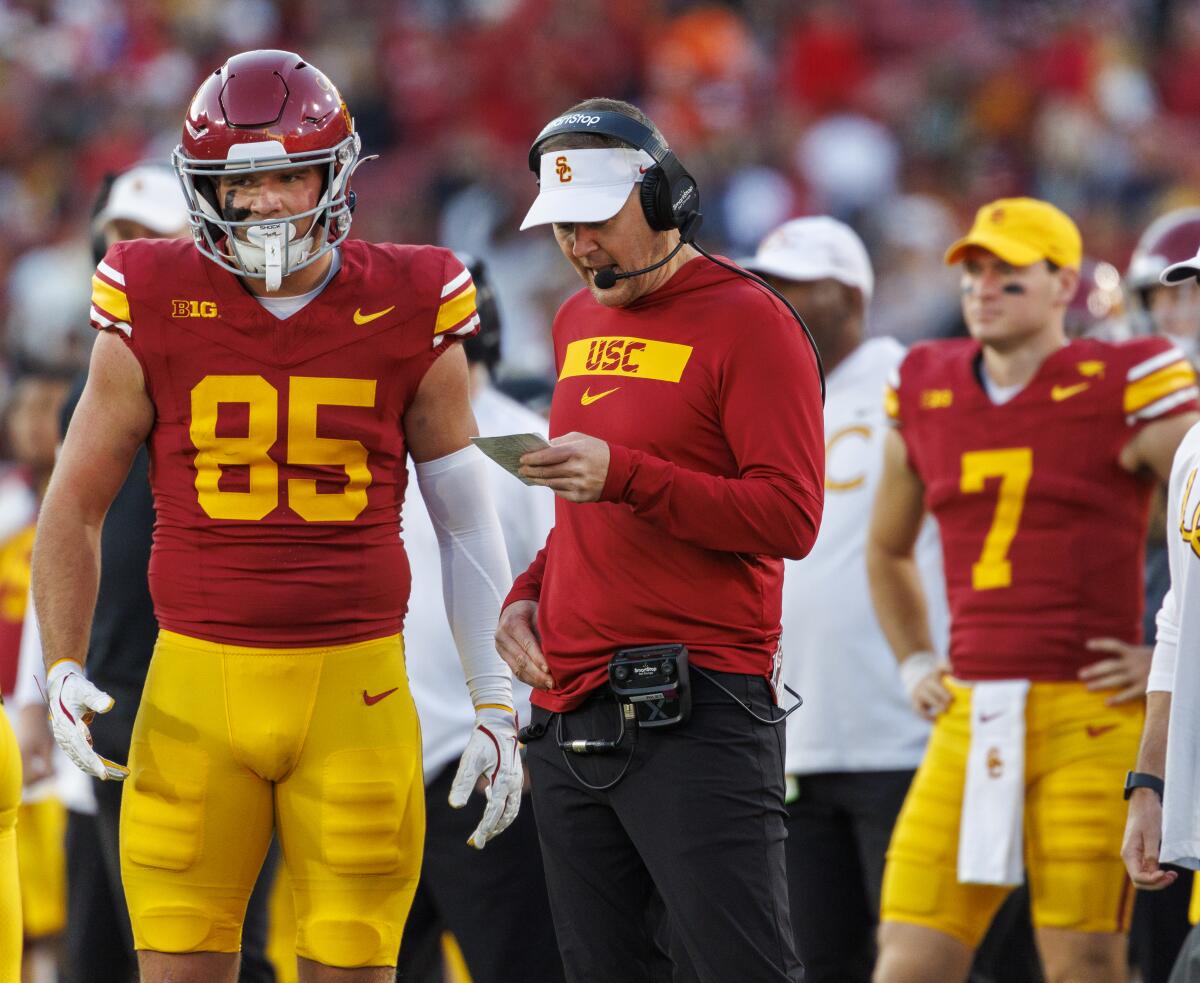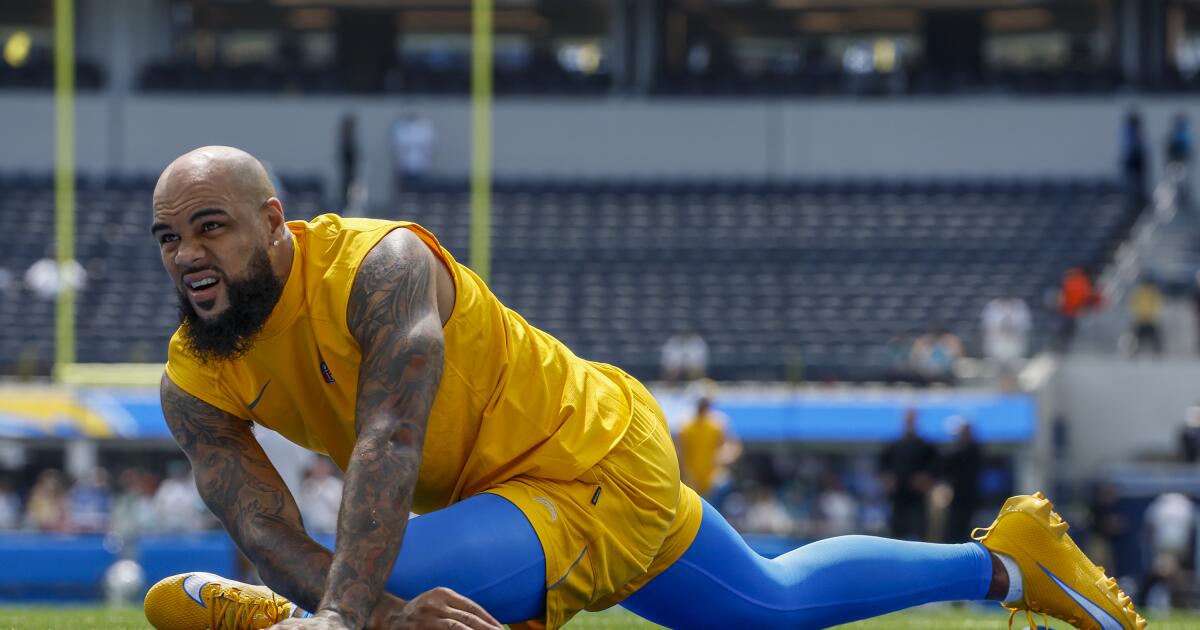Lincoln Riley is deploying two tight ends, powering run game
Walker Lyons took his place in the slot and looked right. Lake McRee crouched on the opposite wing and looked left. The two Trojan tight ends had spent all last Saturday night moving around USC’s formations — split out wide, in the backfield, on the line of scrimmage — paving rush lanes and creating mismatches wherever they went.
Now it was third and short, early in the third quarter of USC’s win over Michigan State, and the two of them were on the field together again, forcing the Spartan defense to decide in a hurry just how Lincoln Riley planned to deploy them.
That unpredictability was precisely the point of the position. It’s why the tight end has been a critical tenet of his Riley’s offense since he started as Oklahoma’s offensive coordinator in 2015. No other position, Riley has come to believe, adds more versatility to an offense.
“It’s the one piece that really can truly do everything,” Riley said. “But it’s also the hardest piece to find.”
During his first three seasons as the Trojans coach, Riley struggled to find that unicorn for his USC offense. Let alone two — or even three — at the same time.
In his first season, in 2022, tight ends accounted for just over 3% of the Trojans’ receiving yards. That number rose to 6% in 2023, then 8% in 2024.
But through a spotless first third of this season, tight ends — and Lyons and McRee, primarily — have contributed 20% of USC’s total passing output in 2025. One reason being the availability of McRee, who has battled a multitude of injuries over his college career. Another being that Riley has used more 12 personnel, with two tight ends on the field, this season than he has before at USC.
“It keeps defenses on their toes,” McRee said. “You don’t really know what we’re going to do, run, pass, or do all of the above out of it.”
The use of 12 personnel has generally been on the rise across all levels of football, including in the NFL, where teams have used two tight end sets nearly 24% of the time through three weeks, according to ESPN. At USC, Riley has gone even further than that, utilizing two-tight end sets at least 35% of the time through four games.
It wasn’t hard to see last Saturday night why he’d lean on that particular scheme, as Lyons took off in motion from the slot. The sophomore tight end slowed just before the third-down snap, as if to prepare to run block, then took off sprinting into the flat. At the same time, McRee sprinted through the seam, taking a linebacker with him.
In the backfield, quarterback Jayden Maiava faked a handoff, forcing another linebacker to bite on the run, while Lyons sprinted into the open space the play design had created. Riley’s modern variation of a triple option would work precisely as planned, as Maiava lofted an easy pass to Lyons, who ran 10 yards for his second touchdown in three weeks.
USC tight end Walker Lyons (85) heads onto the field after talking to coach Lincoln Riley.
(Gina Ferazzi / Los Angeles Times)
It was just the sort of play that reminded what Riley was capable of as a playcaller with two talented tight ends at his disposal.
“I’ve missed it,” Riley said. “Because I love the matchups, I love what it creates. I’m excited about what that room has become for us. I think that room is just going to get better.”
When he first started as a college football coach, tight ends weren’t so much on Riley’s radar. Mike Leach, his mentor at Texas Tech, didn’t seek out or use a tight end unless he happened to have one on his roster.
It wasn’t until Riley left for East Carolina that he started to tinker more with the position.
“We started to get more creative, especially in the run game and some of the different things we could do off of it,” Riley said.
Those innovations accelerated at Oklahoma, where, as offensive coordinator, he was fortunate to inherit redshirt freshman Mark Andrews in 2015. By 2017, Sooner tight ends contributed more than 31% of the team’s passing offense. Andrews had 958 yards and eight touchdowns that season, the most of any tight end in college football. He now stars for the Baltimore Ravens.
“We started building more [at Oklahoma],” Riley said. “We started studying people. And, yeah, we got to the point where we were playing with tight ends, so much in so many ways, it became a comfort.”
He wouldn’t have the same security blanket at USC. The tight end room he took over was totally depleted of talent.
The Trojans two most productive tight ends from 2021, Malcolm Epps and Erik Krommenhoek, were out of eligibility. Their promising freshman, Michael Trigg, had transferred. McRee was the only returner with any real experience, and he’d only played in four games before redshirting.
“That room was a ways off, in terms of the depth and skillset and talent we had,” Riley said. “It’s definitely taken some time.”
Lyons’ arrival would be a major inflection point. A four-star recruit, he’d come to USC from a high school offense that regularly utilized two tight ends. He was used to having his hand in the dirt, as well as working as a receiver on the perimeter.
During his recruitment, Riley showed clips of all the different ways he used Andrews at Oklahoma. He felt Lyons could fill a similar role.
“All the things that he did with [tight ends] was definitely intriguing,” Lyons said, “and it definitely made an impact.”
The sheer amount that Riley asks of tight ends in his offense would add another hurdle in actually making that two-pronged role a reality. McRee, for instance, has technically lined up in 16 different spots through four games, according to Pro Football Focus.
“You’ve got to know protections, route concepts, run game — like, you really have to know it all,” Riley said.
Lyons admits it was overwhelming at first.
“But it’s great now,” he says.
The feeling is mutual for Riley, who knows how rare it is to have two tight ends to build an offense around.
“But when you get it,” he said, “it could be really powerful.”

